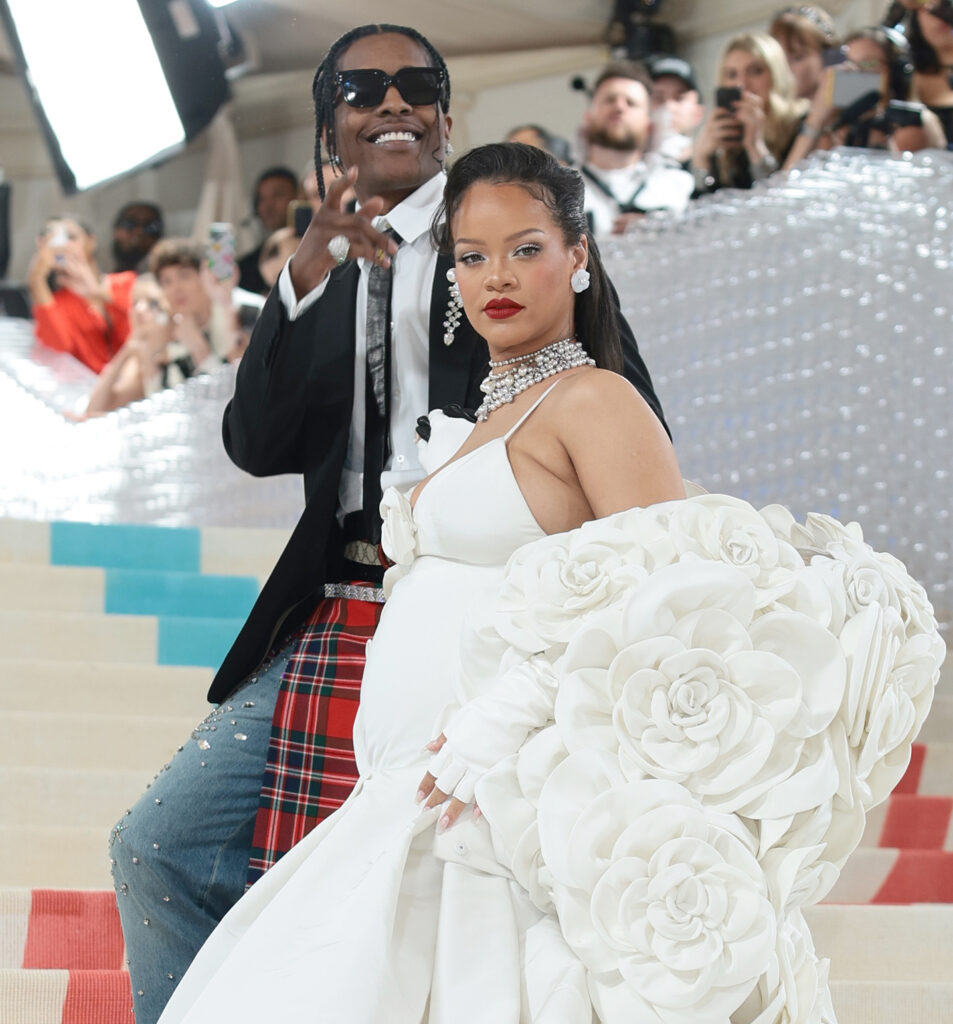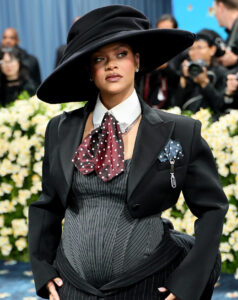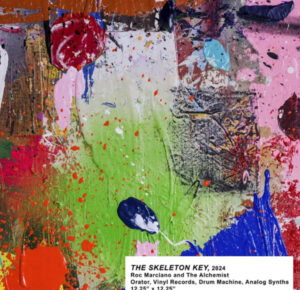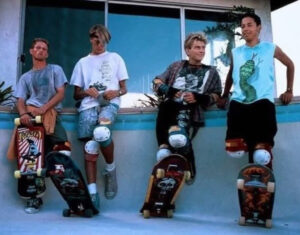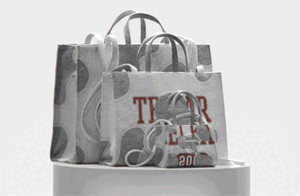The 2025 Met Gala, themed “Technophoria: Fashion in an Age of Artificial Dreams,” was bound to dazzle with its daring fusions of fabric and future. But as the camera flashes faded into routine, the fashion press swirled with whispers, and arrival after arrival blurred into the expected—Rihanna did what only Rihanna can do. She changed the tempo of the night. Draped in custom Marc Jacobs, bathed in light, and unmistakably glowing, she arrived not only as fashion’s most beloved latecomer—but as a soon-to-be mother once again.
The pregnancy reveal was not merely a personal milestone but a masterstroke of performative elegance—an embodied spectacle of power, design, and maternal glamour. With a look that merged dystopian shimmer and intimate serenity, Rihanna turned the Met steps into something more profound: a ceremonial space where fashion, fertility, and fame intertwined. In a night themed around simulated realities, she gave the crowd something real—unmistakably human and emotionally vast.
The Queen of the Met: A Legacy of Late Arrivals and Major Moments
By now, Rihanna’s relationship with the Met Gala is legend. She doesn’t just attend—she architects the evening. From the ornate, jewel-encrusted papal robes by Maison Margiela in 2018’s “Heavenly Bodies” to the cocooning black Balenciaga silhouette in 2021’s “In America: A Lexicon of Fashion,” each arrival is a calculated act of cultural authorship. Her appearances are not red carpet walks—they are revelations.
In 2025, arriving well past the hour when most stars had already posed and paraded, Rihanna emerged at the entrance of the Metropolitan Museum of Art with deliberate slowness. Flanked by Marc Jacobs himself, she floated through the digital haze of flashbulbs, her silhouette unmissable, her hand gently curved beneath a rhinestone-laced belly. Gasps broke into cheers. Phones went up. It wasn’t just an outfit—it was a moment in pop culture history.
The Look: Custom Marc Jacobs and the Language of Luminous Motherhood
Marc Jacobs, a longtime friend and fashion provocateur, designed Rihanna’s ensemble with rare restraint and emotional resonance. Eschewing the futuristic plastics and chrome exoskeletons that dominated the “Technophoria” carpet, Jacobs opted for a rich, body-conscious silhouette that paid homage to both the maternal form and 1930s art deco futurism.
The base was a sheer, smoked amethyst organza gown, draped and gathered with architectural precision, the fabric shimmering with violet-toned crystals that shifted hue under different lights. The bodice featured soft ruched cups and structured shoulders, evoking strength and softness in equal measure. Beneath the translucent layers, a radiant warmth emanated—accentuated by a custom belly jewel, a sculptural sterling silver hand-cradle, forged by artist Casey Curran, gently resting atop her womb.
Her accessories were minimal, calculated: a constellation of diamond ear cuffs by Lorraine Schwartz, a vintage Cartier timepiece strapped over satin gloves, and smoky plum lips that matched the undertones of her gown. Her hair, slicked into a sculptural coil, referenced sci-fi heroines and Yoruba goddesses alike.
In a crowd eager to outdo the machine age with wearable tech, Rihanna reminded everyone that the most transformative force is still biological—and it can be breathtaking.
The Symbolism: Maternal Power in a Digitized World
The 2025 Met Gala’s “Technophoria” theme explored fashion’s relationship to artificial intelligence, augmented bodies, and the emotional possibilities of technological dress. While many attendees wore circuit-inspired gowns, fiber-optic wings, or AI-generated prints, Rihanna’s look positioned the body itself as the ultimate site of creation.
In revealing her pregnancy on this particular night, Rihanna delivered a statement as profound as any algorithm: no machine has yet equaled the capacity of the human form to create life. Her presence became a kind of rebuttal to synthetic futures—a radiant challenge to techno-aesthetic dominance.
Rather than resisting the evening’s theme, she transcended it. What could be more futuristic, more eternal, than maternal continuity? In a world racing toward replication and simulation, Rihanna offered the realest thing: the beginning of a new life, carried in grace.
The Artist and the Muse: Marc Jacobs’ Proudest Moment
For Marc Jacobs, whose career has spanned decades of risk and reinvention, this merge was personal. “She trusted me with a message that couldn’t be diluted,” Jacobs later shared. “It wasn’t about trends—it was about truth.”
Jacobs, known for marrying irreverence with emotional intensity, built the dress not merely for spectacle but for memory. The piece was engineered to move fluidly across Rihanna’s body, to reflect light like skin, to whisper instead of shout. It stood in contrast to the over-styled pageantry of the night—yet outshone nearly all of it.
This was not Marc Jacobs the provocateur. It was Marc Jacobs the poet.
Reclaiming the Pregnant Body in Fashion
Too often, pregnant bodies are forced to accommodate fashion, to hide under empire waists or shrink beneath flowy silhouettes. Rihanna has made it her mission to reverse that logic. During her first pregnancy, she wore custom crop tops, low-slung denim, and sheer lingerie in public—redefining maternity wear not as modest, but as magnetic.
Her 2025 Met appearance continues that legacy. Here, the pregnant body was not veiled—it was celebrated. She didn’t “announce” her pregnancy in the traditional sense. She embodied it in style. The message was clear: the maternal form is not something to hide—it is a couture canvas, a site of cultural power, a fashion statement all its own.
Reactions: A Viral Moment and an Emotional Uprising
By midnight, Rihanna’s reveal had gone viral across every platform imaginable. The photos of her arrival—slow motion, crystalline, womb-forward—flooded timelines, timelines, and front pages. Fans took to X (formerly Twitter) with breathless adoration:
“Rihanna just gave the Met its reason to exist.”
“This is how you do fashion as narrative.”
“She wore life to a gala about machines.”
The cultural response was not just aesthetic—it was emotional. In an era where even celebrity feels flattened by repetition, Rihanna reminded the world that fashion still has the power to move.
Beyond the Steps: What This Means for Celebrity, Femininity, and Fashion
Rihanna’s Met Gala appearance didn’t just close the night—it opened up larger dialogues.
On celebrity: She continues to define fame on her own terms. She shows up when she’s ready. She reshapes the night around her presence. In a celebrity culture obsessed with access and oversharing, Rihanna maintains a regal boundary—then breaks it spectacularly when she chooses.
On femininity: Rihanna’s embrace of her pregnant body challenges archaic norms around beauty and motherhood. Her fashion-forward maternity is not just personal—it’s political.
On fashion: She expands the role of the red carpet from vanity to storytelling. Her dress wasn’t simply a garment—it was a cultural artifact, a visual announcement, a legacy in motion.
The Afterglow: A Cultural Shift Already Underway
In the days following the Gala, fashion critics, maternity advocates, and cultural theorists alike unpacked Rihanna’s appearance. Think pieces poured in about the politics of pregnancy, the future of body-centric fashion, and the metaphoric power of her timing.
Meanwhile, designers took note. Expect maternity wear to see a renaissance—one driven not by utility but by unapologetic sensuality. Expect red carpets to re-engage with emotional storytelling. And expect future Met Galas to be measured against this one.
The influence is already underway.
A Final Note: The Power of One Woman and a Bump
In 2025, in an event dedicated to the artificial, Rihanna made it unmistakably clear: there is nothing more powerful than the real. No fabric, no drone, no pixel could match the sincerity of her moment. And in custom Marc Jacobs, she redefined not only what a Met Gala moment can be—but what fashion, at its highest level, is meant to do.
To captivate. To commemorate. To create.
No comments yet.

